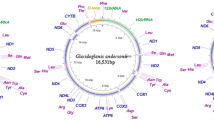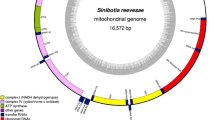Abstract
The family Cyprinidae is widely distributed in East Asia, and has the important phylogenetic significance in the fish evolution. In this study, the 5′ end partial sequences (containing exon 1, exon 2 and indel 1) of S6K1 gene were obtained from 30 representative species in Cyprinidae and outgroup using PCR amplification and sequencing. The phylogenetic relationships of Cyprinidae were reconstructed with neighbor joining (NJ), maximum parsimony (MP), maximum likelihood (ML), and Bayesian methods. Myxocyprinus asiaticus (Catostomidae) was assigned to the outgroup taxon. Similar phylogenetic relationships within the family Cyprinidae were achieved with the four analyses. Leuciscini and Barbini were monophyletic lineages respectively with the high nodal supports. Leuciscini comprises Hypophthalmichthyinae, Xenocyprinae, Cultrinae, Gobioninae, Acheilognathinae and East Asian species of Leuciscinae and Danioninae. Monophyly of East Asian clade was supported with high nodal support. Barbini comprises Schizothoracinae, Barbinae, Cyprininae and Labeoninae. The monophyletic lineage consisting of Danio rerio, D. myersi, and Rasbora trilineata was basal in the tree. In addition, the large fragment indels in intron 1 were analyzed to improve the understanding of Cyprinidae relationships. The results showed that the large fragment indels were correlated with the relations among species. Some conserved regions in intron 1 were thought to be involved in the functional regulation. However, no correlation was found between sequence variations and species characteristic size.
Similar content being viewed by others
References
Chen Y Y. Fauna Sinica, Osteichthyes, Cypriniformes (II) (in Chinese). Beijing: Science Press, 1998. 1–11
Chen X L, Le P Q, Lin R D. Major groups within the family Cyprinidae and their phylogenetic relationships. Acta Zootaxonomica Sin (in Chinese), 1984, 9 (4): 424–440
Howes G J. Systematics and biogeography: An overview. In: Winfield I J, Nelson J S, eds. Cyprinid Fishes: Systematics, Biology and Exploitation. London: Chapman and Hall, 1991. 1–33
Yue P Q. Fauna Sinica, Osteichthyes, Cypriniformes (III) (in Chinese). Beijing: Science Press, 2000. 1–8
Simons A M, Mayden R L. Phylogenetic relationships of the western North American phoxinins (Actinopterygii:cyprinidae) as inferred from mitochondrial 12S and 16S ribosomal RNA sequences. Mol Phylogenet Evol, 1998, 9: 308–329, 9562988, 10.1006/mpev.1997.0467, 1:CAS:528:DyaK1cXivVaiurs%3D
Simons A M, Mayden R L. Phylogenetic relationships of North American cyprinids and assessment of homology of the open posterior myodome. Copeia, 1999, (1): 13–21, 10.2307/1447380
He S, Chen Y, Nakajima T. Sequences of cytochrome b gene for primitive cyprinid fishes in East Asia and their phylogenetic concerning. Chin Sci Bull, 2001, 46: 661–665, 1:CAS:528:DC%2BD3MXjvVagsb4%3D, 10.1007/BF03182830
He S, Liu H, Chen Y, et al. Molecular phylogenetic relationships of eastern Asian Cyprinidae (Pisces: cyprinidformes) inferred from cytochrome b sequences. Sci China Ser C-Life Sci, 2004, 47(2): 130–138, 10.1360/03yc0034, 1:CAS:528:DC%2BD2cXjvVGku7k%3D
Wang X, He S, Chen Y. Sequence variations of the S7 ribosomal protein gene in primitive cyprinid fishes: Implication on phylogenetic analysis. Chin Sci Bull, 2002, 47(19): 1638–1643, 10.1360/02tb9360, 1:CAS:528:DC%2BD38XotVCrtb0%3D
Wang X, Liu H, He S, et al. Sequence analysis of cytochrome b gene indicated that East Asian group of cyprinid subfamily Leuciscinae (Teleostei:Cyprinidae) evolved independently. Prog Natl Sci, 2004, 14(2): 132–137, 10.1080/10020070412331343261, 1:CAS:528:DC%2BD2cXitVaqsb4%3D
Shima H, Pende M, Chen Y, et al. Disruption of the p70s6k/p85s6k gene reveals a small mouse phenotype and a new functional S6 kinase. EMBO J, 1998, 17: 6649–6659, 9822608, 10.1093/emboj/17.22.6649, 1:CAS:528:DyaK1cXnvF2jt70%3D
Ruvinsky I, Meyuhas O. Ribosomal protein S6 phosphorylation: From protein synthesis to cell size. Trends Biochem Sci, 2006, 31(6): 342–348, 16679021, 10.1016/j.tibs.2006.04.003, 1:CAS:528:DC%2BD28XlvFyrsbc%3D
Fumagalli S, Thomas G. S6 phosphorylation and signal transduction. In: Sonenberg N, et al. eds. Translational Control of Gene Expression. New York: Cold Spring Harbor Laboratory Press, 2000. 695–717
Holz M K, Blenis J. Identification of S6 kinase 1 as a novel mammalian target of rapamycin (mTOR)-phosphorylating kinase. J Biol Chem, 2005, 280: 26089–26093, 15905173, 10.1074/jbc.M504045200, 1:CAS:528:DC%2BD2MXlvFymtrw%3D
Holz M K, Ballif B A, Gygi S P, et al. mTOR and S6K1 mediate assembly of the translation preinitiation complex through dynamic protein interchange and ordered phosphorylation events. Cell, 2005, 123: 569–580, 16286006, 10.1016/j.cell.2005.10.024, 1:CAS:528:DC%2BD2MXht1yktrvK
Garcia-Bellido A, Cortes F, Milan M. Cell interactions in the control of size in drosophila wings. Proc Natl Acad Sci USA, 1994, 91: 10222–10226, 7937866, 10.1073/pnas.91.21.10222, 1:STN:280:DyaK2M%2FisVSitQ%3D%3D
Sambrook J, Fritsch E, Maniatis T. Molecular Cloning: A Laboratory Manual. New York: Cold Spring Harbor Laboratory Press, 1989
Thompson J D, Gibson T J, Plewniak F. The Clustal X windows interface: Flexible strategies for multiple sequences alignment aided by quality analysis tools. Nucl Acids Res, 1997, 25: 4876–4882, 9396791, 10.1093/nar/25.24.4876, 1:CAS:528:DyaK1cXntFyntQ%3D%3D
Swofford D L. PAUP: Phylogenetic analysis using Parsimony, Version 4. Sinauer, Sunderland, Massachusetts, 2002
Kumar S, Tamura K, Nei M. MEGA3: Integrated software for molecular evolutionary genetics analysis and sequence alignment. Brief Bioinform, 2004, 5: 150–163, 15260895, 10.1093/bib/5.2.150, 1:CAS:528:DC%2BD2cXntFGqu7s%3D
Xia X, Xie Z. DAMBE: Data analysis in molecular biology and evolution. J Hered, 2001, 92: 371–373, 11535656, 10.1093/jhered/92.4.371, 1:STN:280:DC%2BD3MvptlagtA%3D%3D
Posada D, Crandall K A. Modeltest: Testing the model of DNA substitution. Bioinformatics, 1998, 14(9): 817–818, 9918953, 10.1093/bioinformatics/14.9.817, 1:CAS:528:DyaK1MXktlCltw%3D%3D
Huelsenbeck J P, Ronquist F. MRBAYES: Bayesian inference of phylogeny. Bioinformatics, 2001, 17: 754–755, 11524383, 10.1093/bioinformatics/17.8.754, 1:STN:280:DC%2BD3MvotV2isw%3D%3D
Ronquist F, Huelsenbeck J P. MRBAYES 3: Bayesian phylogenetic inference under mixed model. Bioinformatics, 2003, 19: 1572–1574, 12912839, 10.1093/bioinformatics/btg180, 1:CAS:528:DC%2BD3sXntlKms7k%3D
Matthee C A, Eick G, Willows-Munro S, et al. Indel evolution of mammalian introns and the utility of non-coding nuclear markers in eutherian phylogenetics. Mol Phylogenet Evol, 2007, 42: 827–837, 17101283, 10.1016/j.ympev.2006.10.002, 1:CAS:528:DC%2BD2sXisVCnsLY%3D
Montagne J, Stewart M J, Stocker H, et al. Drosophila S6 kinase: A regulator of cell size. Science, 1999, 285: 2126–2129, 10497130, 10.1126/science.285.5436.2126, 1:CAS:528:DyaK1MXmt12jsLY%3D
Author information
Authors and Affiliations
Corresponding author
Additional information
Supported by the Development Plan of the State Key Fundamental Research of China (Grant No. 2004CB117402), the National Natural Science Foundation of China (Grant No. 30530120) and Chinese Postdoctoral Science Foundation (Grant No. 2005037684)
Rights and permissions
About this article
Cite this article
Kong, X., Wang, X., Gan, X. et al. Phylogenetic relationships of Cyprinidae (Teleostei: Cypriniformes) inferred from the partial S6K1 gene sequences and implication of indel sites in intron 1. SCI CHINA SER C 50, 780–788 (2007). https://doi.org/10.1007/s11427-007-0076-3
Received:
Accepted:
Published:
Issue Date:
DOI: https://doi.org/10.1007/s11427-007-0076-3




